IT’S JAI SHRI RAM TIME
With 22nd January and the grand Ram Janmabhoomi inauguration inching closer, I have a question for you.
Did you know that the constitution of India has a picture of the divine trio of Rama, Sita and Lakshmana on its cover? I had no idea. Was I shocked to discover this? Not at all. Because I grew up believing that ancient India was a Hindu civilisation which embraced tolerance for multiculturalism and multi-theism.
But what about those who believe otherwise? As George Orwell famously said, “The most effective way to destroy a people is to deny and obliterate their own understanding of their history.”
Halfway through reading this book, I was reminded of the passionate arguments of Pavan Varma put forth in his book ‘The Great Hindu Civilisation: Achievement, Neglect, Bias and the way Forward.’ He says, that this great Hindu civilisation existed ‘for thousands of years without extensive or intrusive foraging invasion until the coming of Islam in about 10th century CE.’
Our five bookstrapping insights are presented as questions – to make room for every reader to think of their unique responses.
Did you know that Britain has an official religion – Anglican Christianity? They believe that ‘it is the tolerance that Christianity demands of British society that provides space for other religious faiths too’. The author cleverly imagines replacing Christianity for Hinduism, and says that these words could sound like RSS chief Mohan Bhagwat. What say?
A quote by Savarkar in the book goes thus – ‘after all, there is……but a single race-the human race kept alive by one common blood. All other talk is at best provisional, a makeshift and only relatively true. Was Savarkar an integrationist then?
Is singing Vande Mataram, an act of apostasy for the Muslims in India? The ‘national song’ equates country with ‘motherland’ and praises the Hindu Goddesses Durga and Lakshmi as part of its lyrics. Since the Muslims don’t treat country as God, but Allah as God, isn’t this a complex situation? And was the objection to ‘Vande Mataram’ just another argument to partition the country in the late 1930s?
On 15th August 1947, at the stroke of midnight, the ‘intellectual’ Jawaharlal Nehru agreed to participate in a Hindu ceremony, to seal the transfer of power from the British to Indians. A Raj Purohit handed him a sacred ‘Sengol’ (sceptre) as part of a religious ceremony and drew a streak of sacred ash across Nehru’s forehead. Did you know this?
In his autobiography, L K Advani wrote about the demolition of the Babri Masjid, “It was the saddest day in my life. I have seldom felt as dejected and downcast as I felt that day.” He expressed his guilt that the demolition of the Masjid dented their credibility in the eyes of the people.
The questions this book raises are extremely pertinent. Who were we? Who are we going to be? What is the idea of Bharat? And what is our new ‘tryst with destiny.’ Authors Rahul Shivshankar and Siddhartha Talya have put together a modern tome for ready reference.
Here’s a quiz based on this review for readers of BookStrapping.
What was handed over to Pdt.Jawarharlal Nehru to symbolise the transfer of British power to India, at midnight on 15th August 1947 and why?
Send your responses to reeta@reetaramamurthygupta.in The most detailed and accurate response will get featured in the next review.
Reeta Ramamurthy Gupta is a columnist and bestselling biographer. She is credited with the internationally acclaimed Red Dot Experiment, a decadal six-nation study on how ‘culture impacts communication.’ On Instagram @OfficialReetaGupta
